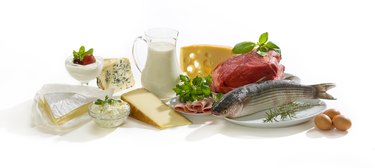
Shingles is a rash caused by a type of herpes virus that also causes chicken pox. If you've had chicken pox, you're at risk of getting shingles at some point during your lifetime. Because the amino acids lysine and arginine play a role in the ability of the herpes virus to replicate, some people make temporary dietary changes as a natural remedy to help shorten a shingles outbreak. There are no recent human studies to show whether or not this approach works, however.
What It Is
Video of the Day
Herpes refers to a family of related viruses that commonly infects humans. The one that causes shingles is called varicella-zoster and is not the same type of herpes that triggers cold sores. Because it affects clusters of nerve cells in your body, the first sign of a shingles outbreak is typically tingling or burning in a particular location on the body. This progresses to a rash consisting of fluid-filled blisters. Shingles outbreaks are typically treated with antiviral drugs. Healthy people who are treated early usually recover in three to five weeks, according to the National Institutes of Health.
Video of the Day
Role of Arginine and Lysine
Protein foods contain varying amounts of amino acids, two of which are lysine and arginine. The herpes virus is able to use the amino acid arginine to reproduce in the nucleus of your cells. Its ability to replicate helps the virus successfully infect your body during an outbreak. The amino acid lysine exerts antiviral effects by blocking the activity of arginine, which helps suppress the virus's ability to replicate. Because of this, some people eat foods with a high ratio of lysine to arginine at the first sign of an outbreak.
High-Lysine, Low-Arginine Foods
Protein foods like dairy, poultry, fish and beef are rich in lysine and comparatively low in arginine. Choose common dairy foods such as yogurt, cheese and milk for their rich lysine content, and select reduced-fat varieties when possible. Salmon, haddock, tuna, herring and perch are good fish in this category, while chicken breast is a good poultry option. Beef is particularly rich in lysine, with a higher ratio of lysine to arginine, and cuts like loin and round are lower in saturated fat.
Foods to Avoid
Because fruits and vegetables are typically low in protein, most are also low in lysine and arginine. But tomatoes, blackberries, grapes and blueberries have an unfavorable ratio of lysine to arginine.
Nuts and seeds are protein foods that are significantly richer in arginine than lysine. People aiming to increase their lysine intake and reduce their arginine intake may want to temporarily limit nuts and seeds, especially peanuts, walnuts, hazelnuts, Brazil nuts, pecans, sesame seeds, pumpkin seeds, peanuts and almonds.